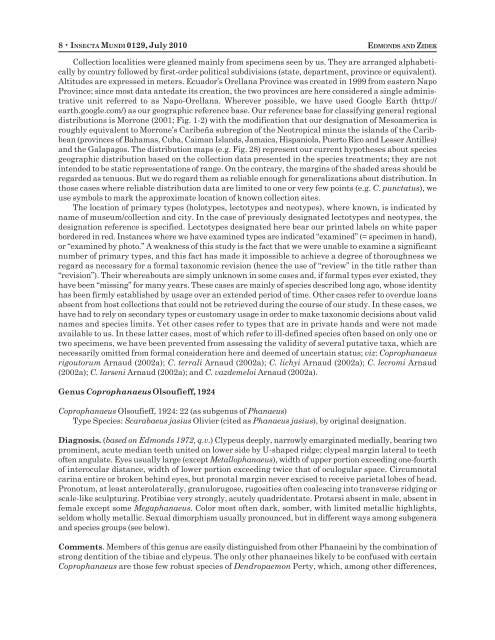insecta mundi - Center for Systematic Entomology
insecta mundi - Center for Systematic Entomology
insecta mundi - Center for Systematic Entomology
You also want an ePaper? Increase the reach of your titles
YUMPU automatically turns print PDFs into web optimized ePapers that Google loves.
8 • INSECTA MUNDI 0129, July 2010 EDMONDS AND ZIDEK<br />
Collection localities were gleaned mainly from specimens seen by us. They are arranged alphabetically<br />
by country followed by first-order political subdivisions (state, department, province or equivalent).<br />
Altitudes are expressed in meters. Ecuador’s Orellana Province was created in 1999 from eastern Napo<br />
Province; since most data antedate its creation, the two provinces are here considered a single administrative<br />
unit referred to as Napo-Orellana. Wherever possible, we have used Google Earth (http://<br />
earth.google.com/) as our geographic reference base. Our reference base <strong>for</strong> classifying general regional<br />
distributions is Morrone (2001; Fig. 1-2) with the modification that our designation of Mesoamerica is<br />
roughly equivalent to Morrone’s Caribeña subregion of the Neotropical minus the islands of the Caribbean<br />
(provinces of Bahamas, Cuba, Caiman Islands, Jamaica, Hispaniola, Puerto Rico and Lesser Antilles)<br />
and the Galapagos. The distribution maps (e.g. Fig. 28) represent our current hypotheses about species<br />
geographic distribution based on the collection data presented in the species treatments; they are not<br />
intended to be static representations of range. On the contrary, the margins of the shaded areas should be<br />
regarded as tenuous. But we do regard them as reliable enough <strong>for</strong> generalizations about distribution. In<br />
those cases where reliable distribution data are limited to one or very few points (e.g. C. punctatus), we<br />
use symbols to mark the approximate location of known collection sites.<br />
The location of primary types (holotypes, lectotypes and neotypes), where known, is indicated by<br />
name of museum/collection and city. In the case of previously designated lectotypes and neotypes, the<br />
designation reference is specified. Lectotypes designated here bear our printed labels on white paper<br />
bordered in red. Instances where we have examined types are indicated “examined” (= specimen in hand),<br />
or “examined by photo.” A weakness of this study is the fact that we were unable to examine a significant<br />
number of primary types, and this fact has made it impossible to achieve a degree of thoroughness we<br />
regard as necessary <strong>for</strong> a <strong>for</strong>mal taxonomic revision (hence the use of “review” in the title rather than<br />
“revision”). Their whereabouts are simply unknown in some cases and, if <strong>for</strong>mal types ever existed, they<br />
have been “missing” <strong>for</strong> many years. These cases are mainly of species described long ago, whose identity<br />
has been firmly established by usage over an extended period of time. Other cases refer to overdue loans<br />
absent from host collections that could not be retrieved during the course of our study. In these cases, we<br />
have had to rely on secondary types or customary usage in order to make taxonomic decisions about valid<br />
names and species limits. Yet other cases refer to types that are in private hands and were not made<br />
available to us. In these latter cases, most of which refer to ill-defined species often based on only one or<br />
two specimens, we have been prevented from assessing the validity of several putative taxa, which are<br />
necessarily omitted from <strong>for</strong>mal consideration here and deemed of uncertain status; viz: Coprophanaeus<br />
rigoutorum Arnaud (2002a); C. terrali Arnaud (2002a); C. lichyi Arnaud (2002a); C. lecromi Arnaud<br />
(2002a); C. larseni Arnaud (2002a); and C. vazdemeloi Arnaud (2002a).<br />
Genus Coprophanaeus Olsoufieff, 1924<br />
Coprophanaeus Olsoufieff, 1924: 22 (as subgenus of Phanaeus)<br />
Type Species: Scarabaeus jasius Olivier (cited as Phanaeus jasius), by original designation.<br />
Diagnosis. (based on Edmonds 1972, q.v.) Clypeus deeply, narrowly emarginated medially, bearing two<br />
prominent, acute median teeth united on lower side by U-shaped ridge; clypeal margin lateral to teeth<br />
often angulate. Eyes usually large (except Metallophanaeus), width of upper portion exceeding one-fourth<br />
of interocular distance, width of lower portion exceeding twice that of oculogular space. Circumnotal<br />
carina entire or broken behind eyes, but pronotal margin never excised to receive parietal lobes of head.<br />
Pronotum, at least anterolaterally, granulorugose, rugosities often coalescing into transverse ridging or<br />
scale-like sculpturing. Protibiae very strongly, acutely quadridentate. Protarsi absent in male, absent in<br />
female except some Megaphanaeus. Color most often dark, somber, with limited metallic highlights,<br />
seldom wholly metallic. Sexual dimorphism usually pronounced, but in different ways among subgenera<br />
and species groups (see below).<br />
Comments. Members of this genus are easily distinguished from other Phanaeini by the combination of<br />
strong dentition of the tibiae and clypeus. The only other phanaeines likely to be confused with certain<br />
Coprophanaeus are those few robust species of Dendropaemon Perty, which, among other differences,



